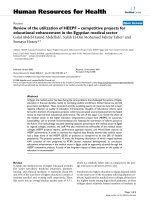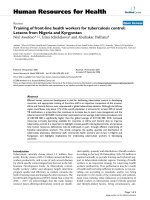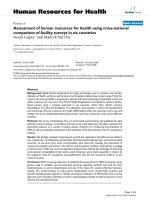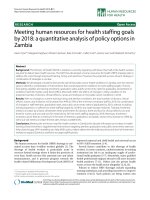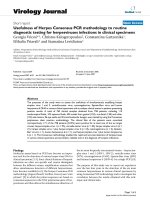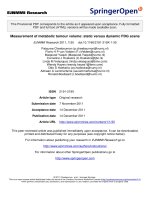Báo cáo sinh học: " Existence of solutions for perturbed abstract measure functional differential equations" pot
Bạn đang xem bản rút gọn của tài liệu. Xem và tải ngay bản đầy đủ của tài liệu tại đây (213.74 KB, 12 trang )
This Provisional PDF corresponds to the article as it appeared upon acceptance. Fully formatted
PDF and full text (HTML) versions will be made available soon.
Existence of solutions for perturbed abstract measure functional differential
equations
Advances in Difference Equations 2011, 2011:67 doi:10.1186/1687-1847-2011-67
Xiaojun Wan ()
Jitao Sun ()
ISSN 1687-1847
Article type Research
Submission date 5 August 2011
Acceptance date 23 December 2011
Publication date 23 December 2011
Article URL />This peer-reviewed article was published immediately upon acceptance. It can be downloaded,
printed and distributed freely for any purposes (see copyright notice below).
For information about publishing your research in Advances in Difference Equations go to
/>For information about other SpringerOpen publications go to
Advances in Difference
Equations
© 2011 Wan and Sun ; licensee Springer.
This is an open access article distributed under the terms of the Creative Commons Attribution License ( />which permits unrestricted use, distribution, and reproduction in any medium, provided the original work is properly cited.
Existence of solutions for perturbed abstract measure func-
tional differential equations
Xiaojun Wan and Jitao Sun
∗
Department of Mathematics, Tongji University, Shanghai 200092, China
Email: XW: ;
∗
;
∗
Corresponding author
Abstract
In this article, we investigate existence of solutions for perturbed abstract measure functional differential equations.
Based on the Arzel`a–Ascoli theorem and the fixed point theorem, we give sufficient conditions for existence of
solutions for a class of perturbed abstract measure functional differential equations. Our system includes the
systems studied in some previous articles as special cases and our sufficient conditions for existence of solutions
are less conservative. An example is given to illustrate the effectiveness of our existence theorem of solutions.
1 Introduction
Abstract measure differential equations are more general than difference equations, differential equations,
and differential equations with impulses. The study of abstract measure differential equations was initiated
by Sharma [1] in 1970s. From then on, properties of abstract measure differential equations have been
1
researched by various authors. But up to now, there were only some limited results on abstract measure
differential equations can be found, such as existence [2–6], uniqueness [2, 3, 5], and extremal solutions [3,
4, 6]. There were also several researches on abstract measure integro-differential equations [7, 8]. The study
on abstract measure differential equations is still rare.
Recently, there were a number of focuses on existence problems, for example, see [9–11] and references
therein, and functional differential equations were also investigated widely, such as work done in [12–14].
However, there were only very few results on existence of solutions for abstract measure functional differential
equations.
There were some consideration on abstract measure delay differential equations [2] and perturbed abstract
measure differential equations [4]. However, to the best of authors’ knowledge, there were not any results
dealing with perturbed abstract measure functional differential equations. In this article, we investigate the
existence of solutions for perturbed abstract measure functional differential equations. This is a problem
of difficulty and challenge. Based on the Leray–Schauder alternative involving the sum of two operators
[15] and the Arzel`a–Ascoli theorem, the existence results of our system is derived. The perturbed abstract
measure functional differential system researched in this paper includes the systems studied in [2, 4] as
special cases. Additionally, considering appropriate degeneration, our sufficient conditions for existence of
solutions are also less conservative than those in [2, 4], respectively. The study in the previous articles are
improved.
The content of this article is organized as follows: In Section 2, some preliminary fact is recalled; the
perturbed abstract measure functional differential equation is proposed, as well as some relative notations.
In Section 3, the existence theorem is given and strict proof is shown; two remarks are given to analyze that
our existence results are less conservative. In Section 4, an example is used to illustrate the effectiveness of
our results for existence of solutions.
2 Preliminary
Definition 2.1 Let X be a Banach space, a mapping T : X → X is called D-Lipschitzian, if there is a
continuous and nondecreasing function φ
T
: R
+
→ R
+
such that
T x − T y ≤ φ
T
(x − y)
for all x, y ∈ X, φ
T
(0) = 0. T is called Lipschitzian, if φ
T
(x) = ax, where a > 0 is a Lipschitz constant.
Furthermore, T is called a contraction on X, if a < 1.
2
Let T : X → X, where X is a Banach space. T is called totally bounded, if T (M ) is totally bounded for
any bounded subset M of X. T is called completely continuous, if T is continuous and totally bounded on
X. T is called compact, if T (X) is a compact subset of X. Every compact operator is a totally bounded
operator.
Define any convenient norm · on X. Let x, y be two arbitrary points in X, then segment xy is defined
as
xy = {z ∈ X|z = x + r(y − x), 0 ≤ r ≤ 1}.
Let x
0
∈ X be a fixed point and z ∈ X, 0x
0
⊂ 0z, where 0 is the zero element of X. Then for any x ∈ x
0
z,
we define the sets S
x
and S
x
as
S
x
= {rx| − ∞ < r < 1},
S
x
= {rx| − ∞ < r ≤ 1}.
For any x
1
, x
2
∈ x
0
z ⊂ X, we denote x
1
< x
2
if S
x
1
⊂ S
x
2
, or equivalently x
0
x
1
⊂ x
0
x
2
.
Let ω ∈ [0, h], h > 0. For any x ∈ x
0
z, x
ω
is defined by
x
ω
< x, x − x
ω
= ω.
Let M denote the σ-algebra which generated by all subsets of X, so that (X, M) is a measurable space.
Let ca(X, M) be the space consisting of all signed measures on M. The norm · on ca(X , M) is defined
as:
p = |p|(X),
where |p| is a total variation measure of p,
|p|(X) = sup
π
∞
i=1
|p(E
i
)|, E
i
⊂ X,
where π : {E
i
: i ∈ N} is any partition of X. Then ca(X , M) is a Banach space with the norm defined above.
Let µ be a σ-finite positive measure on X. p ∈ ca(X, M) is called absolutely continuous with respect to
the measure µ, if µ(E) = 0 implies p(E) = 0 for some E ∈ M. And we denote p µ.
Let M
0
denote the σ-algebra on S
x
0
. For x
0
< z, M
z
denotes the σ-algebra on S
z
. It is obvious that M
z
contains M
0
and the sets of the form S
x
, x ∈ x
0
z.
Given a p ∈ ca(X, M) with p µ, consider perturbed abstract measure functional differential equation:
dp
dµ
= f (x, p(S
x
ω
)) + g(x, p(S
x
), p(S
x
ω
)), a.e. [µ] on x
0
z,
(1)
3
and
p(E) = q(E), E ∈ M
0
.
(2)
where q is a given signed measure,
dp
dµ
is a Radon-Nikodym derivative of p with respect to µ. f : S
z
×R → R,
g : S
z
× R × R → R. f(x, p(S
x
ω
)) and g(x, p(S
x
), p(S
x
ω
)) are µ-integrable for each p ∈ ca(S
z
, M
z
).
Define
|f(x, p(·))| = sup
ω ∈[0,h ]
|f(x, p(S
x
ω
))|,
|g(x, p, p(·))| = sup
ω∈[0 ,h ]
|g(x, p(S
x
), p(S
x
ω
))|.
Definition 2.2 q is a given signed measure on M
0
. A signed measure p ∈ ca(S
z
, M
z
) is called a solution of
(1)–(2), if
(i) p(E) = q(E), E ∈ M
0
,
(ii) p µ on x
0
z,
(iii) p satisfies (1) a.e. [µ] on x
0
z.
Remark 2.1 The system (1)–(2) is equivalent to the following perturbed abstract measure functional integral
system:
p(E) =
E
f(x, p(S
x
ω
))dµ +
E
g(x, p(S
x
), p(S
x
ω
))dµ, E ∈ M
z
, E ⊂ x
0
z
q(E), E ∈ M
0
.
We denote a solution p of (1)–(2) as p( S
x
0
, q).
Definition 2.3 A function β : S
z
× R × R → R is called Carath´eodory, if
(i) x → β(x, y, z) is µ-measurable for each ( y, z) ∈ R × R,
(ii) (y, z) → β(x, y, z) is continuous a.e. [µ] on x
0
z.
The function β defined as the above is called L
1
µ
-Carath´eodory, further if
(iii) for each real number r > 0, there exists a function h
r
(x) ∈ L
1
µ
(S
z
, R
+
) such that
|β(x, y, z)| ≤ h
r
(x) a.e. [µ] on x
0
z
for each y ∈ R, z ∈ R with |y| ≤ r, |z| ≤ r.
4
Lemma 2.1 [15] Let B
r
(0) and B
r
(0) denote, respectively, the open and closed balls in a Banach algebra
X with center 0 and radius r for some real number r > 0. Suppose A : X → X, B : B
r
(0) → X are two
operators satisfying the following conditions:
(a) A is a contraction, and
(b) B is completely continuous.
Then either
(i) the operator equation Ax + Bx = x has a solution x in B
r
(0), or
(ii) there exists an element u ∈ ∂B
r
(0) such that λA(
u
λ
) + λBu = u for some λ ∈ (0, 1).
3 Main results
We consider the following assumptions:
(A
0
) For any z ∈ X satisfies x
0
< z, the σ-algebra M
z
is compact with respect to the topology generated
by the pseudo-metric d defined by
d(E
1
, E
2
) = |µ|(E
1
∆E
2
), E
1
, E
2
∈ M
z
.
(A
1
) µ({x
0
}) = 0.
(A
2
) q is continuous on M
z
with respect to the pseudo-metric d defined in (A
0
).
(A
3
) There exists a µ-integrable function α : S
z
→ R
+
such that
|f(x, y
1
(·)) − f(x, y
2
(·))| ≤ α(x)|y
1
(·) − y
2
(·)| a.e.[µ] on x
0
z.
(A
4
) g(x, y, z(·)) is L
1
µ
-Carath´eodory.
Theorem 3.1 Suppose that the assumptions (A
0
)–(A
4
) hold. Further if α
L
1
µ
< 1 and there exists a real
number r > 0 such that
r >
F
0
+q+h
r
L
1
µ
1−α
L
1
µ
(3)
where F
0
=
x
0
z
|f(x, 0)|dµ. Then the system (1)–(2) has a solution on x
0
z.
5
Proof: Consider the open ball B
r
(0) and the closed ball B
r
(0) in ca(S
z
, M
z
), with r satisfying the inequality
(3). Define two operators A : ca(S
z
, M
z
) → ca(S
z
, M
z
), B : B
r
(0) → ca(S
z
, M
z
) as:
Ap(E) =
E
f(x, p(S
x
ω
))dµ, E ∈ M
z
, E ⊂ x
0
z
0, E ∈ M
0
.
Bp(E) =
E
g(x, p(S
x
), p(S
x
ω
))dµ, E ∈ M
z
, E ⊂ x
0
z
q(E), E ∈ M
0
.
Now we prove the operators A and B satisfy conditions that are given in Lemma 2.1 on ca(S
z
, M
z
) and
B
r
(0), respectively.
Step I. A is a contraction on ca(S
z
, M
z
).
Let p
1
, p
2
∈ ca(S
z
, M
z
). Then by assumption (A
3
)
|Ap
1
(E) − Ap
2
(E)| = |
E
f(x, p
1
(S
x
ω
))dµ −
E
f(x, p
2
(S
x
ω
))dµ|
≤
E
α(x) sup
ω
|p
1
(S
x
ω
) − p
2
(S
x
ω
)|dµ
≤
E
α(x)|p
1
− p
2
|(S
x
)dµ
≤ α
L
1
µ
|p
1
− p
2
|(E)
for all E ∈ M
z
.
Considering the definition of norm on ca(S
z
, M
z
), we have
Ap
1
− Ap
2
≤ α
L
1
µ
p
1
− p
2
,
for all p
1
, p
2
∈ ca(S
z
, M
z
). So A is a contraction on ca(S
z
, M
z
).
Step II. B is continuous on B
r
(0).
Let {p
n
}
n∈N
be a sequence of signed measures in B
r
(0), and {p
n
}
n∈N
converges to a signed measure p.
In case E ∈ M
z
, E ⊂ x
0
z, using dominated convergence theorem
lim Bp
n
(E) = lim
n→∞
E
g(x, p
n
(S
x
), p
n
(S
x
ω
))dµ
=
E
g(x, p(S
x
), p(S
x
ω
))dµ
= Bp(E).
In case E ∈ M
0
, lim
n→∞
Bp
n
(E) = q(E) = Bp(E). Obviously, B is a continuous operator on B
r
(0).
6
Step III. B is a totally bounded operator on B
r
(0).
Let {p
n
}
n∈N
be a sequence of signed measures in B
r
(0), then p
n
≤ r(n ∈ N). Next we show that
{Bp
n
}
n∈N
are uniformly bounded and equicontinuous.
First, {Bp
n
}
n∈N
are uniformly bounded. Let E ∈ M
z
, and E = F
G, where F ∈ M
0
and G ∈ M
z
, G ⊂
x
0
z. F
G = ∅. Hence,
|Bp
n
(E)| ≤ |q(F )| +
G
|g(x, p
n
(S
x
), p
n
(S
x
ω
))|dµ
≤ |q(F )| +
G
h
r
(x)dµ,
consequently,
Bp
n
= |Bp
n
|(S
z
) = sup
∞
i=1
|Bp
n
(E
i
)| ≤ q + h
r
L
1
µ
,
for every p
n
∈ B
r
(0). Then {Bp
n
}
n∈N
are uniformly bounded.
Second, {Bp
n
}
n∈N
is an equicontinuous sequence in ca(S
z
, M
z
). Let E
i
∈ M
z
, and E
i
= F
i
G
i
, where
F
i
∈ M
0
and G
i
∈ M
z
, G
i
⊂ x
0
z, and F
i
G
i
= ∅. i = 1, 2.
Considering assumption (A
4
), then
|Bp
n
(E
1
) − Bp
n
(E
2
)| ≤ |q(F
1
) − q(F
2
)| + |
G
1
g(x, p
n
(S
x
), p
n
(S
x
ω
))dµ
−
G
2
g(x, p
n
(S
x
), p
n
(S
x
ω
))dµ|
≤ |q(F
1
) − q(F
2
)|
+
G
1
∆G
2
|g(x, p
n
(S
x
), p
n
(S
x
ω
))|dµ
≤ |q(F
1
) − q(F
2
)| +
G
1
∆G
2
h
r
(x)dµ.
when d(E
1
, E
2
) → 0, E
1
→ E
2
. Then, F
1
→ F
2
, and |µ|(G
1
∆G
2
) = d(G
1
∆G
2
) → 0.
Considering assumption (A
2
), q is continuous on compact M
z
implies it is uniformly continuous on M
z
.
so
|Bp
n
(E
1
) − Bp
n
(E
2
)| → 0, as d(E
1
, E
2
) → 0
for every p
n
∈ B
r
(0).
{Bp
n
}
n∈N
is an equicontinuous sequence in ca(S
z
, M
z
).
According to the Arzel `a–Ascoli theorem, there is a subset {Bp
n
k
}
n,k∈N
of {Bp
n
}
n∈N
that converges
uniformly. Thus, op erator B is compact on B
r
(0). Then, B is a totally bounded operator on B
r
(0).
From steps II and III, the operator B is completely continuous on B
r
(0).
Step IV. (1)–(2) has a solution on x
0
z.
7
Now, by applying Lemma 2.1, we show that (i) holds. Otherwise, there exists an element u ∈ ca(S
z
, M
z
)
with u = r such that λA(
u
λ
) + λBu = u for some λ ∈ (0, 1).
If it is true, we have
u(E) =
λ
E
f(x,
u(S
x
ω
)
λ
)dµ + λ
E
g(x, u(S
x
), u(S
x
ω
))dµ, E ∈ M
z
, E ⊂ x
0
z
λq(E), E ∈ M
0
.
for some λ ∈ (0, 1). Then
|u(E)| ≤ |λA(
u(E)
λ
)| + |λB(u(E))|
≤ λ|q(F )| + λ
G
[|f(x,
u(S
x
ω
)
λ
) − f(x, 0)| + |f (x, 0)|]dµ
+λ
G
|g(x, u(S
x
), u(S
x
ω
))|dµ
≤ |q(F )| +
G
α(x)|u(S
x
ω
)|dµ +
G
|f(x, 0)|dµ +
G
h
r
(x)dµ
≤ |q(F )| + α
L
1
µ
|u(E)| +
G
|f(x, 0)|dµ +
G
h
r
(x)dµ.
so we get
|u(E)| ≤
|q(F )| +
G
|f(x, 0)|dµ +
G
h
r
(x)dµ
1 − α
L
1
µ
,
for all E ∈ M
z
.
By the definition of the norm on ca(S
z
, M
z
),
u ≤
q + F
0
+ h
r
L
1
µ
1 − α
L
1
µ
.
As u = r, we have
r ≤
q + F
0
+ h
r
L
1
µ
1 − α
L
1
µ
.
This is a contradiction. Consequently, the equation p(E) = Ap(E) + Bp(E) has a solution p(S
x
0
, q) ∈
B
r
(0) ⊂ ca(S
z
, M
z
). It is said that (1)–(2) has a solution on x
0
z. The proof of Theorem 3.1 is completed.
Remark 3.1 If f (x, y) = 0 and ω is a given constant, then system (1)–(2) degenerates into
dp
dµ
= g(x, p(S
x
), p(S
x
ω
)), a.e. [µ] on x
0
z,
(4)
and
p(E) = q(E), E ∈ M
0
,
(5)
8
obviously, (4)–(5) is the system (4) considered in [2]. Additionally, our degenerated assumptions for the
existence theorem equal to (A
1
)–(A
4
) in [2], the more complex assumption (A
5
) [2] is not necessary. So our
results are less conservative.
Remark 3.2 If ω = 0, then system (1)–(2) degenerates into
dp
dµ
= f (x, p(S
x
)) + g(x, p(S
x
)), a.e. [µ] on x
0
z,
(6)
and
p(E) = q(E), E ∈ M
0
.
(7)
obviously, (6)–(7) is the system (3.6)–(3.7) studied in [4]. Additionally, our degenerated assumptions for the
existence theorem equal to (A
0
)–(A
2
) and (B
0
)–(B
1
) in [4], the more complex assumption (B
2
) [4] is not
necessary. So, our results are less conservative.
4 Example
Let p ∈ ca(S
z
, M
z
) with p µ. Consider the equation as follows:
dp
dµ
= α(x)|p(S
x
ω
)| +
h
r
(x)|p(S
x
)+p(S
x
ω
)|
1+|p(S
x
)+p(S
x
ω
)|
, a.e. [µ] on x
0
z,
(8)
and
p(E) = q(E), E ∈ M
0
.
(9)
where h
r
(x) ∈ L
1
µ
(S
z
, R
+
), α
L
1
µ
< 1 and 0 ≤ ω ≤ h(h > 0). f : S
z
× R → R and g : S
z
× R × R → R are
defined as
f(x, y(·)) = α(x)|p(S
x
ω
)|,
g(x, y, z(·)) =
h
r
(x)|p(S
x
) + p(S
x
ω
)|
1 + |p(S
x
) + p(S
x
ω
)|
.
It is obvious that the assumptions (A
0
) − (A
2
) hold. Then, we show that f and g satisfy the assumptions
(A
3
) and (A
4
), respectively.
First, f is continuous on ca(S
z
, M
z
).
|f(x, y
1
(·)) − f(x, y
2
(·))| ≤ |α(x)| sup
ω
||p
1
(S
x
ω
)| − |p
2
(S
x
ω
)||
≤ |α(x)| sup
ω
|p
1
(S
x
ω
) − p
2
(S
x
ω
)|
= |α(x)||y
1
(·) − y
2
(·)|,
9
f(x, y(·)) satisfies (A
3
).
Second, |g(x, y, z(·))| ≤ h
r
(x). g(x, y, z(·)) satisfies the assumption (A
4
).
Thus, if there exists r ∈ R satisfies r >
F
0
+q+h
r
L
1
µ
1−α
L
1
µ
with F
0
=
x
0
z
|f(x, 0)|dµ, all conditions in
Theorem 3.1 are satisfied. So, (8)–(9) has a solution p(S
x
0
, q) on x
0
z.
Competing interests
The authors declare that they have no competing interests.
Authors’ contributions
JS directed the study and helped inspection. XW carried out the main results of this paper, including the
existence theorem and the example. All the authors read and approved the final manuscript.
Acknowledgments
This study was supported by the National Science Foundation of China under grant 61174039, and by the
Fundamental Research Funds for the Central Universities of China. The authors would like to thank the
editor and the reviewers for their constructive comments and suggestions to improve the quality of the article.
References
1. Sharma, RR: An abstract measure differential equation. Proc. Am. Math. Soc. 32, 503–510 (1972)
2. Dhage BC, Chate DN, Ntouyas SK: A system of abstract measure delay differential equations. Electron.
J. Qual. Theory Diff. Equ. 8, 1–14 (2003)
3. Dhage BC, Chate DN, Ntouyas SK: Abstract measure differential equations. Dyn. Syst. Appl. 13,
105–117 (2004)
4. Dhage BC, Bellale SS: Existence theorems for perturbed abstract measure differential equations. Nonlin-
ear Anal. 71, e319–e328 (2009)
5. Joshi SR, Kasaralikar SN: Differential inequalities for a system of abstract measure delay differential
equations. J. Math. Phys. Sci. 16, 515–523 (1982)
10
6. Shendge GR, Joshi SR: Abstract measure differential inequalities and applications. Acta Mathematica
Hungarica 41, 53–59 (1983)
7. Dhage BC: On abstract measure integro-differential equations. J. Math. Phys. Sci. 20, 367–380 (1986)
8. Dhage BC: Existence theory for quadratic perturbations of abstract measure integro-differential equations.
Diff. Equ. Appl. 1, 307–323 (2009)
9. Chen FL, Luo XN, Zhou Y: Existence results for nonlinear fractional difference equation. Adv. Diff.
Equ. 713201 (2011)
10. Han XL, Gao HL, Xu J: Existence of positive solutions for nonlocal fourth-order boundary value problem
with variable parameter. Fixed Point Theory Appl. 604046 (2011)
11. Plubtieng S, Sitthithakerngkiet K: Existence result of generalized vector quasiequilibrium problems in
locally G-convex spaces. Fixed Point Theory Appl. 967515 (2011)
12. Wang LG: Intuitionistic fuzzy stability of a quadratic functional equation. Fixed Point Theory Appl.
107182 (2010)
13. Park C: Fixed points, inner product spaces, and functional equations. Fixed Point Theory Appl. 713675
(2010)
14. Zhang JJ, Liao LW: Further extending results of some classes of complex difference and functional
equations. Adv. Diff. Equ. 404582 (2010)
15. Dhage BC, O’Regan D: A fixed point theorem in Banach algebras with applications to functional integral
equations. Funct. Diff. Equ. 7, 259–267 (2000)
11
